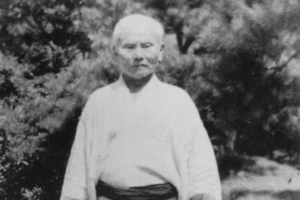Quote from Gichin Funakoshi
“Beginners must master low stance and posture; natural body positions are for the advanced; formal stances are for beginners; later, one stands naturally”.

Hitotsu, kamae wa shoshinsha ni ato wa shizentai
This principle from Gichin Funakoshi encapsulates the essence of stances in Karate. Early in a martial artist’s journey, learning formal stances is essential. These stances provide a foundation for balance, technique, and control. As practitioners advance, the rigidness of these stances begins to dissolve, and they evolve into more natural, adaptable postures suitable for real-world situations.
The Role of Stances for Beginners
For beginners, stances are not just about position; they are about building core fundamentals. The low stances, such as Zenkutsu-dachi, Kokutsu-dachi, Naihanchi-dachi and Neko-ashi-dachi, are crucial for teaching:
-
Balance: Stability is key when executing techniques, and mastering stances teaches the practitioner how to maintain their center of gravity over their base.
-
Stability: Lower stances bring the body’s center of gravity closer to the ground, making it harder to be thrown or pushed off balance.
-
Technique Precision: The structure of the stance helps reinforce the correct form when performing strikes, blocks, or kicks, ensuring that the practitioner applies power efficiently.
For beginners, these stances serve as a structure that reinforces proper posture and body mechanics. However, the goal is not simply to stand in a particular way but to understand the importance of each stance in relation to movement, power generation, and defensive capability.
Stability vs. Mobility in Karate
The Importance of Low Gravity
One significant feature of many traditional Karate stances is their low center of gravity. Low stances such as Sanchin-dachi and Zenkutsu-dachi bring the practitioner’s hips and legs closer to the ground, creating a solid foundation. This low gravity is essential for several reasons:
-
Balance and Control: With a low center of gravity, the practitioner has a more stable base, which is crucial when executing both offensive and defensive techniques. It is harder for an opponent to unbalance or throw someone whose center of gravity is low.
-
Power Generation: Karate relies on the ability to generate force quickly. Lower stances enable the practitioner to use the ground more effectively, transferring energy from the legs through the body and into the techniques. The deeper the stance, the more potential there is for power, especially in punches and kicks.
-
Defensive Advantage: When facing an opponent, a low stance makes it more difficult for them to land a clean strike, as the practitioner is not as exposed and is better positioned to evade attacks.
While low stances are important, mobility cannot be sacrificed entirely. As Karate practitioners progress, they learn how to balance stability with the need for movement. This is where the transition from formal, low stances to more natural, fluid postures becomes critical.
Moving Beyond Rigid Stances
As students advance, the rigidness of these formal stances begins to loosen. The focus shifts from static positions to dynamic adaptability. This evolution reflects the growth of a Karate practitioner, from learning the fundamentals to applying them naturally in combat situations.
The Transition to Natural Posture (Shizentai)
In advanced stages, Karate practitioners move towards Shizentai (natural stance), which is a more fluid and adaptive posture. This stance is not rigid or fixed but adjusts according to the situation and the individual’s body mechanics. A natural stance allows for:
-
Adaptability: The practitioner can quickly respond to changes in distance, timing, and direction, as their stance flows with their movements instead of limiting them.
-
Speed and Efficiency: A natural stance is more efficient for movement, enabling the practitioner to move quickly in any direction without unnecessary tension.
-
Ease of Transition: In real-life situations or self-defense, the ability to flow between offensive and defensive techniques with minimal pause is crucial. A rigid stance may be too slow or cumbersome in a real fight, where fluidity and speed are key.
Additional Considerations in Connection with Stances in Karate
The Role of Breathing
Breathing plays a crucial role in Karate stances. Proper breathing ensures that the practitioner maintains energy, focus, and fluidity in their movements. Deep, controlled breathing also helps to stabilize the body, especially in low stances where maintaining balance and posture is vital.
Psychological State and Stances
Stances in Karate are not only about physical posture but also reflect the practitioner’s psychological state. A strong, stable stance conveys confidence and readiness. Conversely, a weak or unbalanced stance may signal hesitation or lack of control. As the practitioner matures, their stance becomes a reflection of their mental focus and discipline.
Stances in Kata and Practical Application
In Kata, stances are practiced in a fixed manner to ensure precision and control. However, in free sparring or self-defense, the rigidity of stances may be adapted to the flow of the situation. The principles learned through structured stances in Kata are the foundation for more dynamic and flexible movement when engaging with an opponent.
Conclusion
In summary, stances in Karate are more than just positions; they are essential tools for developing balance, stability, power, and adaptability. Beginners use formal stances to build a strong foundation, while advanced practitioners evolve these stances into natural postures that allow for more flexibility and fluidity in real-world situations. Ultimately, stances are not just about how one stands but about how one adapts to and reacts to the challenges presented in combat. As Gichin Funakoshi’s quote suggests, mastery comes not from rigid adherence to form, but from the ability to move naturally while maintaining control and balance.
Thanks for reading
Cheers, Gert
